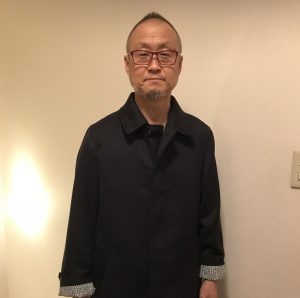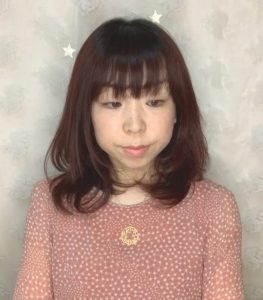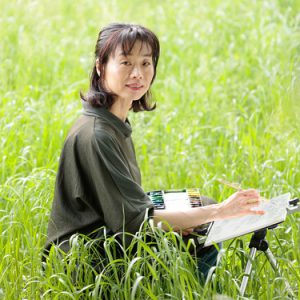#13ゲスト:浦賀 静登
Guest of June 2021: Mr.Shizuto Uraga
今月のゲスト:浦賀 静登 (Shizuto Uraga)
ジャンル:講師 キルト、バッグデザイナー
プロフィール:
1989年 11月
故河島博氏・後藤一生氏と共に、ミシンパッチワークキルトプロジェクトを発足
1992年 4月
銀座に「キルトアイ」をオープン
1997年8月
㈱ベルニナジャパン設立と同時に入社
2007年7月
ウラガ・ソーイング・プランニング株式会社設立同年6月財団法人日本手芸普及協会(現在:公益財団法人日本手芸普及協会) 日本ヴォーグ社の顧問就任 現在に至る
2008年1月
東京ドーム国際キルト展のJUKIブースで、黒羽志寿子先生、郷家啓子先生、増田順子先生の展示講習会をプロデュース
2011年 1月
東京国際キルトフェスティバル 「額絵キルト部門」に「はいらいつ」入選
2012年 1月
東京国際キルトフェスティバル 「バック部門」に「オールドバック」2位入賞「額絵キルト部門」に「闇からの光」入選
日本のキルトの先生たちからは「ミスターベルニナ」とも呼ばれている。
The Guest of January 2021: Mr. Shizuto Uraga
Genre: Professor/Lecturer/ Fashion, Quilt & Bag Designer
Profile:
Nov. 1989: New project “Patchwork/Quilt/Sewing Machine” Launched sewing machine patchwork quilt project with the late Hiroshi Kawashima and Kazuo Goto.
April 1992: “Quilt Eye” Opened the exhibition at Ginza, Tokyo.
Aug. 1997: Joined Bernina Japan Co., Ltd.
July 2007: Uragana Sewing Planning Co., Ltd. Established June of the same year. (Currently Japan Handicraft Promotion Association). Appointed as an adviser to Japan Vogue – Nihon Vogue Co., Ltd. (A public Interest Incorporated Foundation)
Jan. 2011: Selected for “Hairai” in the “Picture Frame Quilt Category” of the Tokyo International Quilt Festival.
Jan. 2012: Tokyo International Quilt Festival – Awarded 2nd Prize in the Bag Category.
作品
インタビュー音声
The singer of the theme song : Ms. Carmella Constancio (YouTube)
Interviewer : Ms. Carmella Constancio
Q.浦賀さんはどのようなことがきっかけで、こちらの道に進まれるようになったのでしょうか。
元々私はリッカーの倒産後にダイエーが更生計画を受けて入るときに、出向という形で中に入って、そこでスイスのベルニナっていうメーカーのミシンにたどり着いて、そこで取り扱うようになってから…。 まあその時は、基本的に仕事でミシンを扱うっていうことで、自分では作ったりとかするっていうこともなく、大学で機械工学を学んでいたので、分解をしたりコンピューターで作ったり、そういった機械面では興味があって。 アメリカに行ってキルトを習って帰ってきて、「銀座キルトアイ」っていうのを河島博社長と立ち上げて、そこで国内のキルトの先生方のところは当時の日本ヴォーグ社の編集長から紹介いただいて、日本全国飛び回って、いろんな教室の展開をやるんだってことでやったところでこの業界に足を突っ込んで、そのままずっとやってたんですけど… 基本的には自分で作るっていうことは、その当時は興味がなく。色んなところの手法を日本の先生方に広めたいっていう、ただその一心だったんです。 ただ(会社を)辞めて、ベルニナジャパンを初代社長と、1997年8月に立ち上げて、約10年ベルニナでアメリカに行ったりだとか色んなことで、ベルニナのミシンからやはりもっと勉強しないといけないなってことで色んなソフトを学んで…。それと、日本で最初にミシンパッチワークキルトということでスタートしたので、その足跡だけは消したくなかったという気持ちでやっていました。 それで今から13年前にベルニナを辞めて、今の会社を設立する時に日本でも著名な先生方のひと声っていうか…、いつ転んでもまた這い上がればいいんだからっていうことと、辞めるんだったら次は自分で作ることをしないと伝わらないよっていうことで、作り始めたら少し興味がわいてきて。 実際に東京ドームに作品を出して、自分が入選とか入賞とかして、作ることでベルニナのミシンの良さを伝えられるっていう根本がわかったような感じがして。今も作る事=自分のお客様に対してのサービス、に繋がってる。そこから入った感じですね。Q.以前、桂由美さんのパリコレのお仕事をされたということですが詳しくお話しいただけますか?
これはですね…。実は僕キャシー中島さんとも30年近くの付き合いなんです。それでキャシーさんから、「あなた仕事しない?」ってことで、ああ良いですよ~って言ったんです。その時に桂由美さんの名前を言われたと思うんですけど、その前にプロデュースの方とお会いして、“パリコレの仕事”ってことしか頭になかったんですね。「えっパリコレの仕事ができるじゃん」っていうことで、じゃあどんなことするのかっていうことだったんですけど、向こうから既にパターンを貼ってきたものに対して、金糸をジグザグにかけていかないといけない仕事だったんです。10日くらいやったんですけど、それをやるのにベルニナのミシンがなかったらできてないっていうのと、これまでの糸とミシンと布との関係を色んな先生方から教わった経験のおかげで縫えたって言っても過言ではないんですけれども…。本当にそれを10日間朝8時から夜11時までずっとかかりっきりでやったんですけど、すごく楽しかったですね。―そのお仕事では、ドレスをお作りになられたんですか?
そうです!古い(着物)の帯を切ってパッチワークのように、例えば50cmの2mっていう四角いままで作ったもので、あとから型紙で切ってくださいっていう話をしたんですけど、最初からもう型紙に貼ってあったんですよ。ところがその貼り方が、非常に僕らからすると雑で…。まあ当然それはスタッフの方が貼られてるんですけど、それを直しながらやったり。 その後日本でファッションショーをされたときに、それがパンフレットに載っていて、自分の会社なんかも載っていたり。それで(桂由美さんに)招待していただいて、本当にいいところでお会いして、それでちょっとミーハーで写真とかも撮らせて頂いたり(笑)やっぱりキルトの業界でもそうですけど、ああいう上の方っていうのは物腰が優しくてすごくこう…逆に気をつかっていただけるというのが一緒だったなぁと思ってですね…。―これを全部縫ったんですね!?
そうです。貼ってある隙間を全部。金のラメ糸なんですけど、全部ジグザグに、且つ切れないようにしないといけないんですね。 で、その糸も3種類のメーカーの金糸を送ったんです。何mmの幅でこれはいくつっていう見本を糸別に作って送ったんですけど、その時も一番難しく、一番綺麗な糸を選ばれたので…。Q.ご自分のデザインというのを近年やられていると思うんですが、どのようにデザインをされているのでしょうか。着想などもどういった所から得ているんでしょうか。
基本的にはテレビとかで景色とか幾何学的なものが出たときに、面白いなこういう風にならないかなっていうとこで、それを実際ミシンでやるとどうなるのかなっていう形なので…。どちらかというと、学生の時に図面などの線を描いたりする方が機械(科)とかは多いですし、内装関係をやるときも線で図面を描くので、縦横斜め線カーブっていうものの集合体みたいなものをやってみたいって思いますね。それをバッグに表すときもあれば、キルトの中に持ってくることもあるっていう感じです。ラインを使った作品になるので、私の場合は柄ものっていうのはないです。 去年は中止になりましたが、今年はIQFのヒューストンもやってくれるってことで申し込みしたんですけど、それには「手毬」。日本の伝統的な手毬ですよね。色んな手毬の刺繍をしてあるんですけど、その毬のままやるのは面白くないので、じゃあいくつか見えるように、ということで色々線を描きながら…、ちょっと全体の写真はまだお見せできなかったんですけど、一部分はピンクと白のやつ。 多分何も言わないでその作品を見られた方が殆ど言うんですけど、ミシンでやったとは思われないところがあるんですね。というのも、白いところは“ブティ”っていう手縫いの手法があるんですけど、そこの部分は刺し子ミシンでやったんじゃないかって言われるんです。実際には普通のミシン、ベルニナのミシンで縫ってるんですね。ブティの点のところだとか膨らみっていう部分に自分で興味を持って…。 逆に、いろんな先生から言わせると、「手でやるものをミシンでやる必要がないじゃないか」って言われる。それも僕は理解しているんですけど、それでも私はミシン屋なので、ミシンでこういうことが出来るんだっていうことも、ミシンが好きな方とかに努力すればこんなことができるよっていうことを示したいっていうのもあって…。最近はこういう著名な先生方にちょっと、反旗じゃないですけど(笑) 手でやられているようなものを、ミシンでやったんだ、っていう手法がなんかできないかなって、最近はそういうことばかりやってます。Q.皆さん作品ひとつひとつに想いがこめられていると思うんですが、1番特別な作品とそれに込められた想いっていうのを挙げていただけませんか。
(前質問のピンクと白の作品について) これはもう…“チャレンジ”っていう感じですかね。 ミシンでしかできない手法で、しかもこれはある程度キルトの知識がないとできない。それと僕たちのこの技術をサポートしてくれる道具ですね。のりであったり、Sewlineさんの道具で描いたりする物だとか、切ったりするものだとか。全部そういう物がないと、この作品っていうのは出来てないかな。途中で投げ出してる(かもしれない)くらい自分でも初めてのやり方で作ったものですから…。 まあミシンの逆襲じゃないですけど(笑)ミシンもここまでやれば、「手に勝てる」じゃなくて、人に勘違いするだろうなって。刺し子ミシンに勘違いして頂いてもいいし、手縫いだと勘違いしたっていい。でもそれらをやっている方に対してもリスペクトしていますし、そういうものを私のやり方で表現させてもらったっていう感じですね。Q.東北大震災のときに寄付活動をされてたということですが、これは皆さんで作ったものを送ったんですか?
いえ、基本的に最初は電気がないので足踏みミシンを持っていこうかなと思って、車までは乗っけたんです。ただ車で行くとガソリンを自分で持って行かなくちゃいけないじゃないですか。逆に向こうで注ぐようだと迷惑かけるっていうんで、そしたら知ってる東北の先生方から「電気があるところはミシンをメーカーに頼んで、公共のセンターのようなところに送ってほしい」って言われたのでそうしました。それで次に何が欲しいって聞いたら針がない、じゃあ手縫いの針を送るってやったり、糸がない、じゃあ糸も送るっていう、 これは全部メーカーに話をして…。それで布がないって言われたら、どんな布でも買うからって話をして。そしたら昔からのお付き合いのあるところから「浦賀さんこんなものでよければ」って布の反物をいっぱいくださって…、それを送ったり。 それで向こうの現場で、先生方がボランティアでバッグとかですよね。小物入れだとかそういうものを作るって言うので、それをメーカーさんたちにもお願いして、中心になっている先生方のところにお送りしたんですよね?―それでその先生に習って、皆さんでお作りになられたと。
そうです。そこで作ったものをその被災地へ持っていかれるんですね。―そこで震災に遭われた方たちが、そういった創作活動を通して自分たちの気持ちを鎮めるというか。そういったことでお役に立てたということでしょうか。
そうですね。そこですぐに“作る”という気持ちにはなれないんですけど、ちょっと離れた被災地の方でまだマシだった先生方がやっぱりそれを作ろうって言って。そしてそれをお持ちになった方がやっぱり自分たちでもしないといけないねっていう…。 まあ買った物を送るっていうのも良いと思うんですけど、その時は先生が“手作りで”、みんな一緒なんだよっていうことをやりたいって言っていたので。その先生にお任せして、僕は調達をするっていうだけでした。Q.ご自分のこれからの大きな夢だとか、これから挑戦していきたいことなどはありますか。
今は新しいベルニナのロングアームっていうのが日本でも出るようになったので…。まあ金額は金額なんですけど、海外でもどんどん出ているものですし、手法によっては非常に役に立つ機械で、私も5年前スイスに行ったときに初めて使った時に「えっ!」って思ったくらい。 正直その時はあんまり興味なかったんですけどね。ロングアーム自体は知ってたんですが、その時にやっぱり使いづらいっていうのがあったんですけど、身近でこうして使ってみてやっぱりベルニナの技術っていうのはすごいなあと。私がやっても針目揃うんだ、っていう。これは誰がやっても揃うようにできてるっていう、逆に面白くないってところもあるんですけど。でもそれが手助けをしてくれますし、触ってくれた先生や生徒さんから言われるのは、「体に楽だ」って言われるんです。大きなキルトって動かしますよね?フリーモーションで。でも体にかかるキルトの負担って、相当なものなんですよ。 やっぱり日本のキルトの高齢化もかなり進んでますから、そういうミシンばりばりされてる方で、場所とご予算の成立する方に是非体験してもらって、使って頂ければなあと思っています。 今は日本ヴォーグ社のキルト塾のところで1台置いて、お教室で触って頂いても良いように、いつでも使えるように置いています。それがどんどん出て行ってくれたら良いなあって、今から布教していって。もう1回原点に戻って、ベルニナを普及させていけたらいいなという気持ちですね。Q.What made you decide to enter this industry?
I had originally worked at Daiei and was sent to a company called Rikkar, which was bankrupted and was helped by Daiei. I was asked to work for the reorganization plan. As part of the plan, we decided upon BERNINA sewing machines, which are recognized as one of the best sewing machines. That was my beginning to enter this industry. At that time, I dealt with sewing machines as work, but I did not make anything. As I have a back ground in engineering, and sewing machines are mechanical, it was easy for me to handle the sewing machine. Then, I went to the United States to learn how to make quilts with the sewing machine. After that, we opened “Ginza Quilt Eye” as a kind of show room / work shop with Mr. Hiroshi Kawashima. We organized many classes, which were introduced by the Editor-In-Chief of Nihon Vogue (Japan Vogue) publishing company to launch and establish the sewing machines — with various techniques I leaned in the USA. With my passion of the sewing machine, I left the company and established “Bernina JAPAN” with Mr. Kawashima in Aug. 1997. For 10 years, I studied the Bernina sewing machine and learned various software by doing so. Because we first introduced the sewing machine patchwork quilt in Japan, we wanted to keep that achievement, which was the foundation of my passion. Since I started out as the first sewing machine patchwork quilt enterprise in Japan, I didn’t want to erase the footprints! It was 13 years ago that I left Bernina Japan and founded the current company by myself. At that time, a very famous quilting teacher advised me to make something – – otherwise… your passion does not touch the heart of other people. I can’t tell, unless I make it myself. Thanks to that advice, I became interested in (creating) making something! I felt like I realized the basics of being able to convey the quality of Bernina sewing machines by actually putting out works for the Tokyo Dome — and making them by winning or winning prizes! I applied for the contest of Tokyo International Quilt Festival and won some prizes! Then, I gradually understood the principals to explain more about the advantages of the Bernina sewing machine by creating. It is connected to what I still make, which is service for my customers! It feels like I entered from there!Q. You mentioned that you worked (created) for Yumi Katsura’s Paris Fashion Week before. Would you tell us more about it?
I’ve been with Ms. Kathy Nakajima (who is a very famous Hawaiian quilting teacher) for almost 30 years. She asked me to work for Yumi Katsura. After having the meeting, I realized that I would work/create for the Paris Fashion Week Collection and was so excited about it. I was wondering what to do, but it was a job where I had to zigzag gold thread. I found that the patterns were already put onto the fabrics and my work was to sew in zigzag with the gold threads. I did it for about 10 days, but I couldn’t do it without a Bernina sewing machine. And thanks to my long deep learning experience from various teachers about the relationship between threads, sewing machines, and fabrics – – I sewed! It’s no exaggeration to say that…I really did sew for 10 days from 8:00 am to 11:00 pm, and it was a lot of fun!-Did you make a dress for this job?
Yes, that was cut silk (which was originally from a Japanese Kimono Obi (the tie) and aligned like patchwork. For example, I made a 50cm X 2m square; however, the dress paper pattern was already put onto the fabrics roughly. I fixed it correctly…. After the Paris collection fashion show, it was held in Japan, too. That dress was listed in the show pamphlet and also my company was mentioned. (Please refer to the photos.) What was most exciting is that I was invited to the show by YUMI KATSURA (who is a famous fashion designer). I took the photo with her. She was so gentle and caring with the other guests– like the quilting teachers.-Wow, you sewed this all by yourself?
Yes, I sewed all the spaces between each fabric with goldish lame color threads. I sewed in zigzag and also needed to sew without stopping and not cut. I sewed 3M (approx.118inches) like quilting. I had made and sent a sample of how many mm wide and how many threads. It was the most difficult to sew and I chose the most beautiful thread. She chose the most difficult thread… It was really hard to do that!Q. I believe that you have been doing your own designs recently. How do you come up with the design and how do you get the inspiration for your original designs?
Basically, I am interested in geometrical patterns. When a landscape or geometrical thing comes out on TV, it’s like something interesting – what happens when you actually do it with a sewing machine? I imagine the shape. When I was a student, I often drew lines such as drawings in machines. When I do interior work, I draw drawings with lines, so it is a collection of vertical, horizontal and diagonal line curves. I decided I would like to try something like that! As I said before, I studied drawing and also worked for the interior industry. I am really fascinated with the ensemble of various lines and curves. I sometimes arrange it as a design for a bag and also in quilts. As I always use lines, I do not use any printed patterns. It was most unfortunate that the International Quilt Festival (IQF) in Houston was cancelled last year. Therefore, I applied to the contest for IQF this year. The theme of my work is “TEMARI.”―It’s a traditional Japanese Temari, isn’t it?
I have various Temari embroidery embroidered on it, but it’s not fun to do… as it is – – so, I’m drawing various lines so that I can see some of them. (It is a ball of cotton wound tightly around with threads of many colors for bouncing) which is very beautiful and was used for the traditional Japanese ball playing. I did a lot of embroidery work with various colors threads. I can show you a part of my work. You can see the photo of the pink white quilting. You may think that it was made by hand sewing. But, I actually did it with a sewing machine. It looks like hand sewing with the French technique“Boutis”. I am interested in the “stuffing filled” points of Boutis, which was made by hand sewing. It was said that part was done with a Sashiko sewing machine. Actually, you can sew with a normal sewing machine, a Bernina sewing machine. I was there with a world-famous Japanese teacher who said, “Sewing machines are evil.” On the contrary, various teachers say, “You don’t have to do what you do by hand, with a sewing machine.” Some teachers said that if we can do hand sewing, it is not necessary to use the sewing machine. I understand that, but I’m still a sewing machine shop, so the fact that I can do this with a sewing machine also shows that I can do this…if I make an effort with someone who likes sewing machines! This is a big deal. These days, I’m not a little rebellious against these famous teachers (laughs). I’ve been wondering if I could do something that was done by hand with a sewing machine, and I’ve been doing that kind of thing these days! I have worked with sewing machines for a long time and I would like to introduce to people the many things we can do with a sewing machine. I am trying to explore the techniques by sewing machines more… that is what I do now.Q. I think everyone has their own feelings (idea/wish) in each work; but would you mention your most special work and the feelings contained in it?
(About the pink and white quilt which I applied at the International Quilt Fair in Houston, TX this year) It was challenging for me because this is a technique that can only be done with a sewing machine, and this cannot be done without some knowledge of quilts. And it’s a tool that supports our technology. It’s like glue, something that you draw with Sewline’s tools or something that you cut. And that technique can be arranged with the good tools like SEWLINE products (marking, cutting and placing each fabric). Without such great tools, such a master piece cannot be made. It can not be completed and may be finished only half way – – Because this quilt was made with the way of my first experience. Well, it’s not a counterattack of the sewing machine (laughs). You can misunderstand it as a Sashiko sewing machine, or you can misunderstand that it is hand-sewn. But, I also respect those who are using them, and I feel like I was able to express that kind of thing in my own way!Q. We heard that you were doing donations at the time of the Great Tohoku Earthquake. Did you donate quilts that you made to the people who lost their house and family?
No, basically there was no electricity at first, so I thought I should bring a pedal sewing machine. But, if you go by car, you have to bring your own gasoline. Then, the teachers in Tohoku asked me to send the electric sewing machine to a place where they have electric power-like a public center. (I did so.) At that time the Tohoku people would like to do something to ease their feelings and heal their wounded hearts with sewing. I was so struck, when I asked what they want next, (I don’t have a needle) – then I’ll send a hand-sewing needle. (I don’t have thread) Then, I’ll send thread, too. From a business that I had a long-standing relationship with – – he gave me a lot of cloth fabric…and I sent it. That’s why the teachers volunteer to work on bags at the site over there. At the Tohoku area, some teachers voluntarily teach the people how to make bags, accessory cases, etc. I asked many manufacturers to send all those materials to TOHOKU at that time.So you would learn from a teacher there and make it yourself?
That’s right! You can take what you make there to the disaster area. Yes, those bags and pouches were delivered to the severely damaged area.– Is it that those who suffered from the earthquake can calm their feelings through such creative activities? Did that help everyone?
Yes, Of course, people were not so active to make something at that time. But, one of the teachers who were also a victim, but not severely damaged, stood up and said to the people, “Let’s make something”. Then, gradually the people wanted to participate and make something. Of course, there is a way to buy something for them. But, it would be different for them to receive the “handmade” goods and make something for other people in return. Therefore, I just left it to the teacher and procured it!Q. Do you have any big dreams for yourself or something you would like to challenge for yourself in the future?
Now, the new Bernina long arm is coming out in Japan too… of course the price is something… It is becoming more and more popular overseas and it is a very useful machine depending upon the method. I first used a long arm five years ago, when I went to Switzerland, and…To be honest, I wasn’t really interested in that machine at that time. I knew the long arm itself, but at that time it was difficult to use. But after all, Bernina’s technology is amazing – – when I try to use it in this way. I touched the Bernina’s machine; I believe that their innovation and technology is amazing. Actually, it is easy for everyone to align the needle stitches with the Bernina machine. The teachers mentioned that it makes it easy to move a big quilt and not become fatigued at all with free motion. With the increasing ages of quilters, it would be quite useful and I would like to encourage them to touch it and try to use it. It would be quite useful for them to have fun with their work. One machine is kept at the quilt class at the Japan Nihon Vogue quilt school so that anybody can touch it and try to use it. I hope that people recognize such easiness and try to use the sewing machine more. I wish I could go back to the starting point of my life and spread Bernina and continue to do it for a long time!これからもいろいろな分野での第一人者の方、新進気鋭の芸術家の方、ファッション、いろいろな分野の方たちのインタビューを配信させていただきます。
We will continue to deliver compelling interviews with the leading creative artists and influencers in various fields such as art, fashion, cooking, etc…
We hope you’ll be looking forward to many more exciting and interesting creative updates soon!































